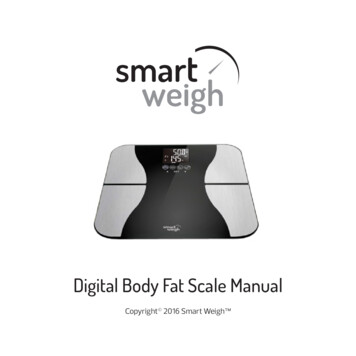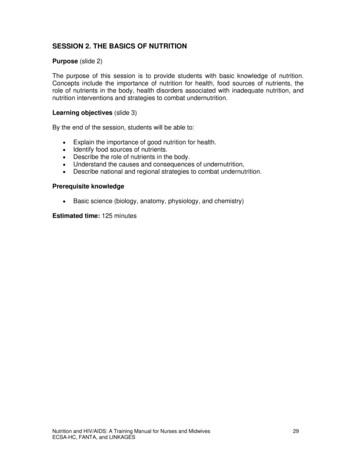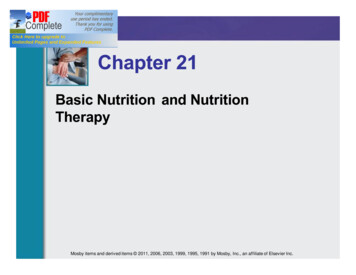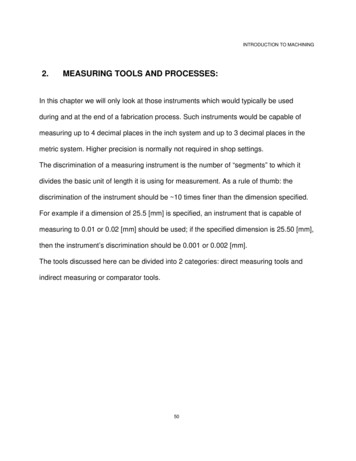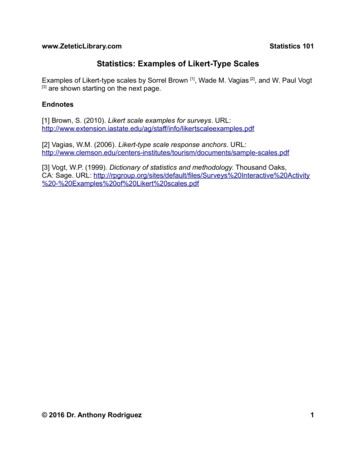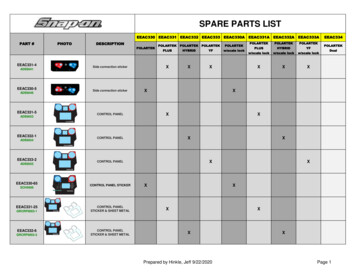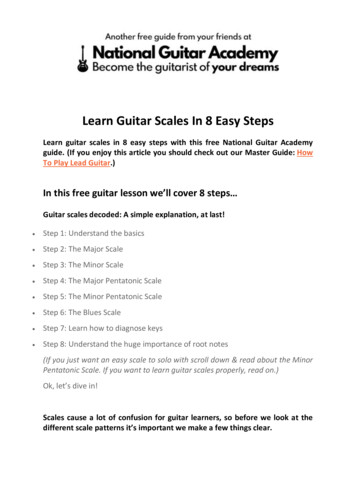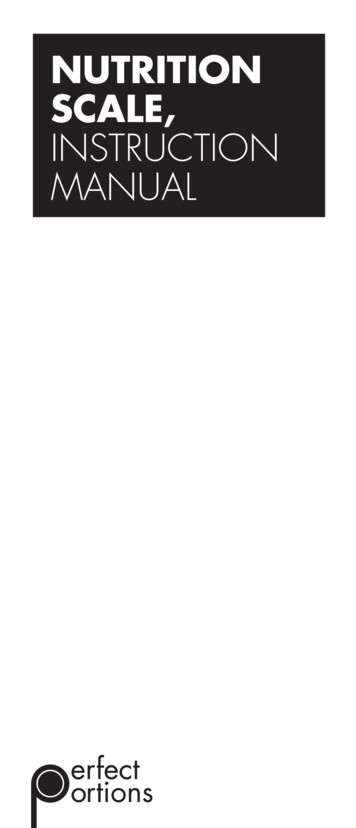
Transcription
NUTRITIONSCALE,INSTRUCTIONMANUAL
TABLE OF CONTENTSBA SI C I N STR UCT ION S & T IP S 2INT R O DUCTI O N 3GE TTI N G TO K N OW Y OU R S C A L E 4SCA L E FUNCTI ON STURNING SCALE ON/OFF 6WEIGHING ITEMS 6WEIGH USING CONTAINER 6ENTERING FOOD CODES 7COMPUTING PERIODIC TOTALS 7COMPUTING A MEAL 8ENTERING CUSTOM FOOD CODES 8USING CUSTOM FOOD CODES 9CAR I NG FO R YOU R S C A L E 1 0MA N UFA CTUR E R ’ S WA R RA N T Y 1 0USE O F DATA 11GL O SSA RY 12SPECI FI CATI O N S 1 4
BASIC INSTRUCTIONS1. Place the scale on a clean, level surface. Pressthe ON/OFF key on the right side of the scale;the four digit food code will be blinking.2. To use a plate or other container to weigh food, putempty plate and/or container on scale. PressZERO.3. Find the desired food code in the food code booklet. Enter the 4 digit food code number startingwith 1 or 0.4. Put food on the scale: calculations will appear inthe display window.OPTIONAL:5. Press the G/OZ key to toggle between English(lb/oz) and metric (g) units of measurement.6. Press SAVE to store nutritional information.7. Press TOTAL to view stored nutritional information. Press TOTAL again to exit total mode.8. To weigh another food item, press CLEAR andrepeat steps 2 through 4.QUICK TIPS & REFERENCE- Computing a meal, page 7.- Programming and custom food codes, page 8.- Do not place food on scale before turning on. Thescale auto-tares.- For info on ZERO, see page 6.- Cleaning the scale, page 9.2 BASI C I N S T R U C T I O N S & T I P S
INTRODUCTIONWelcome to your new Perfect Portions Scale—a stateof-the-art Nutrition Scale that weighs your food and simultaneously calculates the amount of 10 key nutritionalelements:- Calories- Calories from Fat- Carbohydrates (in grams)- Protein (in grams)- Fat (in grams)- Saturated Fat (in grams)- Fiber (in grams)- Sugars (in grams)- Cholesterol (in grams/milligrams)- Sodium (in grams/milligrams)Additionally, the scale will calculate the percent daily value for the most of these elements based on a daily dietof 2,000 calories.The Perfect Portions nutritional scale is designed toserve the needs of health conscious individuals whowant to establish and maintain a healthy lifestyle. Thismeans making a gradual change in your eating habits– becoming increasingly conscious of what you chooseto eat and the implications for your health and sense ofwell being.Although the Perfect Portions nutritional scale provides aconvenient way to create a nutritious diet, perhaps a moreimportant function is to help those who use it to monitorand manage food choices and portion sizes day by day.As the scale helps you to become familiar with the nutritional content of many common foods, you can learn tomake decisions with confidence at the grocery store, inrestaurants and other places where the scale isn’t available. Our idea of portion size has been exaggerated bythe huge quantities of food often served in restaurants.The scale will show the relationship between portion sizeand calorie and nutrient content and allow you to makebetter nutrition decisions for your family.The Perfect Portions nutritional scale is a highly sensitive and accurate piece of equipment. It can measurethe nutritional values for individual foods or entire meals.The scale also calculates and stores cumulative nutrienttotals. Users may want to keep a journal to record theirdaily nutritional intake over time and to share the information with their physician or nutrition professional.IN T ROD U C T ION 3
GETTING TO KNOWYOUR SCALEOPERATING MODES – the Perfect Portions scalecan be in one of the following three operating modes:NORMAL, PROGRAM, or TOTAL.NORMAL mode is the standard operating mode inwhich you can enter a food code and weigh items.When you turn on the scale, it starts in this mode.PROGRAM mode is used to enter user defined, custom food codes. This mode is entered by pushing theCUSTOM key for 3 seconds until you hear the scalebeep twice.TOTAL mode is entered and exited by pressing theTOTAL key. Note that “Total” will be shown near thebottom right corner of the display when in this mode.This mode is useful for tasks such as displayingcumulated nutritional information over the course ofa day.THE DISPLAY – the Perfect Portions scale displaysthe 10 different nutritional values and the weight ingrams or pounds and ounces. The food code numberfor the food being weighed also appears in the displaywindow.Displaying AmountDisplaying %DVREMOVE PACKING MATERIALS – Be sure to removethe battery pull-tab from the back of the scale before using your scale for the first time.4 GE TT I N G TO K NOW Y OU R S C A L E
GETTING TO KNOWYOUR SCALETHE CONTROLS – includes 18 keys which allow youto select functions, enter numbers (such as those representing food codes), and toggle (switch back and forth)between certain functions. Each function will be explained in detail in the following list.ON/OFF: Used to turn the scale on and off. The button islocated on the right side of the scale.Number keys 0-9: To enter numbers as required.SAVE key: Press SAVE to store the nutritional information shown on the display to the nutritional informationcumulative total. This is helpful for tracking nutritionalintake over time.CLEAR key: The Clear key has three functions:- Press CLEAR in NORMAL mode to clear the currentfood code. The four digit food code number will flashto signify the scale is ready to accept another food codeentry.- It is used to clear entries. All entries repeatedly flash onand off when the scale is ready to accept input in aparticular field. Press clear to zero any blinking field.- Press and hold CLEAR for 3 seconds in TOTAL modeto clear the stored, cumulative total.CUSTOM key: The CUSTOM key has two functions.- Press CUSTOM and enter a two digit number to retrieve auser defined custom food code.- Press and hold CUSTOM for 3 seconds to enter userdefined, custom food code for up to 99 of your mostcommonly consumed foods.G/OZ key: used to toggle between metric (g) and English(lbs/oz) units of measure. The button is just next to theON/OFF button on the right side of the scale.ZERO key: The ZERO function allows you to omit theweight of a container and weigh only the food within it.TOTAL key: used to toggle between NORMAL and TOTAL Modes when operating the scale.% DV key: This function toggles the display betweenweight amounts and Percent Daily Values (DV) for thedifferent nutritional values.- Note: The Percent Daily Values are based on a 2,000calorie diet.- Note: A Percent Daily Value is not shown for Fat Calories, Sugars, and Protein.G E TTI N G TO K N OW Y OU R S C A L E 5
SCALE FUNCTIONSTURNING THE SCALE ON AND OFF – Place thescale on a clean, level surface. Push the ON/OFFbutton located on the right side of the scale to turn thescale on. Push it again to turn it off. If you don’t makean entry for several minutes, the scale turns itself offautomaticallyWEIGHING ITEMS - When a food is placed on thescale, its weight will automatically appear next to theWeight heading in the display window. The weight canbe displayed in either metric units (grams) or Englishunits (pounds and ounces). To convert between metric and English units, press the G/OZ key on the rightside of the scale.WEIGH USING A CONTAINER – You may want toweigh foods or ingredients using a container such asa bowl or plate. In these situations, the ZERO functioncan be used to offset the weight of the container sothat only the weight of the food is calculated by thescale. This is also commonly referred to as “tare”.To use the ZERO function, place the empty containeron the scale and press the ZERO key. The weight registered by the scale will return to zero. The scale willdisplay “0” after the Weight heading and “ZERO SET”will be shown on the display. Then, when you placefood in the container, only the food is weighed.If you want to reset the scale for a new measurement,remove all items from the scale and press ZEROagain. The scale can also be reset by turning it offand then back on again.Note: With each different container used, you shouldset a new zero weight.Tip: If you place the empty container on the scale whilethe scale is turned off, the container weight will automatically be zeroed out when you turn the scale on.6 GE TT I N G TO K NOW Y OU R S C A L E
SCALE FUNCTIONSENTERING FOOD CODES – The food code is entered to tell the scale what is being weighed. Eachfood has been assigned a code number from 0001to 1999. Find the food you want to weigh in the FoodCode Booklet, arranged by category. Enter the FoodCode number when the four digit Food Code numberis blinking on the display. The display will show the nutrient value for the amount of food you have placed onthe scale. NOTE: If no food code has been entered,the nutrient values will not be displayed, except whenin the TOTAL mode (see below for more informationon cumulative data).COMPUTING PERIODIC TOTALS – The scale allows you to keep a running total of your nutritional intake by using the TOTAL function. NOTE: The TOTALfunction is active when the word TOTAL appears nearthe bottom right corner of the display. The TOTAL keytoggles between the display of cumulated totals andthe nutrient values of the current food being weighed.When in the TOTAL mode, only the CLEAR functionis available. You must always exit the TOTAL modeby pressing TOTAL again before you can accessother functions. TIP: The word TOTAL will not be visible near the bottom right corner of the display screenonce you have exited the TOTAL mode.TO ADD TO THE CUMULATIVE FOOD TOTAL: Withfood on the scale and the nutrients displayed, pressSAVE. The values will be added to the cumulative foodtotal. Press TOTAL to toggle into the TOTAL mode.Review the cumulative food total. Press TOTAL againto return to NORMAL mode.TO CLEAR THE TOTAL: Press the TOTAL key toenter the TOTAL mode. Press and hold the CLEARkey for 3 seconds to zero the total (You would typically clear the totals before making the first entry ofthe day).G E TTI NG TO K N OW Y OU R S C A L E 7
SCALE FUNCTIONSCOMPUTING A MEAL – When you have learned howto compute totals, you can use the ZERO function tocompute the nutrient value for several food items froma cooked meal by adding them to a plate. Make surethat the total has been cleared before you begin. Let’swalk through an example. First, place the empty plate.On the scale and press the ZERO key. The scale willshow “0” next to WEIGHT. Next, place the first itemon the plate and enter its code. Then press SAVE tostore its nutrient values. Next, press ZERO again, andthe weight will return to zero (but the appropriate nutrient values for the first item have been stored in thescale’s memory). Now add the next item to the plate,press CLEAR, enter its food code, and press SAVEagain to add the nutrient values of this second itemto those stored for the first food item. Repeat until allthe foods for your meal have been added to the plateand saved. To complete the calculations, press TOTAL and the nutrient values for your entire meal willbe displayed.ENTERING CUSTOM FOOD CODES – The scale allows you to program and store up to 99 custom foodcodes for those instances when you want to weigh aningredient or food that is not included in the built-infood code list. It is best to use these custom entriesfor items that are frequently consumed.Tip: Record your custom entries on the back cover ofthe food code book using a permanent marker.To program a custom entry, you need the nutritionalinformation commonly found on the food’s NutritionFacts label. Also, most restaurants can provide thenutrition facts information for their offerings. The standard Nutrition Facts label looks similar to the digitaldisplay on your scale.Note that the nutritional information is typically givenin grams and represents the amount of an individualserving. The weight of one serving is called the serving size, which is also measured in grams. Followthe simple procedure on the next page to store thisinformation in your scale.8 GE TT I N G TO K NOW Y OU R S C A L E
SCALE FUNCTIONSENTERING CUSTOM FOOD CODES CONT– Whenin NORMAL operating mode, press and hold theCUSTOM key until the scale beeps twice. This indicates that the scale is now in the PROGRAM mode.The display will be blank except for a “U” and blinking“00” in the Food Code display area. The blinking digitsindicate that the scale is ready to accept user input.Enter the two digit (01-99) custom food code numberthat you want to use and press the CUSTOM key. Ifyou need to zero the entry, the CLEAR key can beused at any time. After you enter the custom foodcode number, the scale will beep and the 9 nutrientvalues and Weight (per serving) will appear for programming.Starting with Calories, enter the 9 displayed nutrientsin grams exactly as they are listed on the NutritionFacts label. The active nutrient is indicated by theblinking digits. Press the CLEAR key to reset an entryto zero. Always enter the amounts in grams or milligrams, as shown on the label. Press CUSTOM tostore the current entry and move to the next entry.After pressing CUSTOM to store the final nutrient value (Protein), the four digits next to Weight will beginblinking. This is the weight of the individual servingsize. Enter the weight of the serving size in grams.After pressing CUSTOM to store the Weight per serving size, the scale will calculate the nutritional information per 100 grams and store these values tomemory. The scale will then beep twice and return tothe NORMAL operation mode. The custom entry isnow ready for your use.USING CUSTOM FOOD CODES – To make use ofthe nutrient values programmed in the preceding section, make sure the scale is in the NORMAL operating mode and ready to accept a food code entry. Thescale is ready when the food code digits are blinking. Press CUSTOM. The Food code will now showa steady “U” and a blinking “00.” Enter the two digituser code from 01 to 99. Proceed as when using astandard food code entry.G E TTI NG TO K N OW Y OU R S C A L E 9
CARING FOR YOUR SCALECLEANING – Your scale is not waterproof. Never immerse the scale in water or place it in a dishwasher.To clean the scale platform, use a soft, slightly dampcloth or sponge. For stains or other residue, use amild dishwashing soap. Never use harsh cleaners ortreated cloths.CHANGING THE BATTERY – Your scale uses twoAA batteries. To change the batteries, open the battery door on the bottom of the scale, remove the oldbatteries and replace them with the end oriented asshown in the battery compartment.Caution:1. Do not mix old and new batteries.2. Do not mix Alkaline, Standard (Carbon-zinc), orRechargeable (Nickel Cadmium batteries).3. Please dispose of used batteries properly.MANUFACTURER’SWARRANTYYour scale is warranted by the manufacturer againstdefects in materials and workmanship for five (5)years for the original purchaser from the date of purchase. Proof of purchase is required.The warranty is void if the product has been subjectedto mechanical damage or mistreatment, such as immersion. This warranty is in lieu of all other warranties, and limits the liability of the manufacturer. Thiswarranty gives you certain legal rights and you mayhave other rights depending on which state the product was purchased.If your scale is defective, please contact DMD, LLCtoll-free at (866) 991-8494.10 CA R I N G F O R Y O U R S C A L E & WA R R A N T Y
USE OF DATAThe scale contains data derived directly from a U.S.Department of Agriculture Data Base. While the scaleis very sensitive and highly accurate, the nutritionalcontent of foods can be variable. The data given ispresumed to be accurate for the sample the Government tested, but there can be significant variabilityin samples of the same types of food. For example,chocolate cake may be quite different because recipes vary from family to family and bakery to bakery.Similarly, the sugar content of fruits can vary considerably. On the other hand, certain quality-controlledfoods, such as milk, won’t vary much in nutritionalcontent, and others, such as butter, are naturally uniform.For these reasons, the nutritional values displayedby the scale should be considered as a very usefulguide to good nutrition, but not as an absolute measure. In most cases, the accuracy will be sufficient tosupport your dietary requirements. However, we cannot assume any liability related to the accuracy andcompleteness of the information provided, nor to theway in which the information is used by the consumer.Before beginning any diet management program, users should consult with their physician or a registereddietitian.U S E OF D ATA 1 1
GLOSSARYNUTRITIONAL TERMS – Your body depends on thefood you eat to provide nutrients. Nutrients are chemical substances found in foods that are essential forlife processes like breathing, thinking, and digestion.The nutrients found in food are vitamins, minerals, water, fat, protein, and carbohydrates. All foods containsome combination of these nutrients. Only three nutrients supply calories: protein, fat, and carbohydrates.Vitamins, minerals, and water do not supply calories.The following defines the nutrients whose values arecalculated by the scale, as well as other terms theuser may not be familiar with. The definitions will befound in alphabetical order.Calorie – A calorie is a basic unit used to measure theenergy contained in food.Carbohydrate – Carbohydrates are the body’s primary source of readily available energy. The main formsof carbohydrate are sugars and starches. Sourcesof simple carbohydrates include table sugar, candy,and refined flour products. Complex carbohydratesinclude starches like oatmeal, high fiber cereals andwhole wheat flour products.Cholesterol – A wax-like substance that is not soluble in water. There are two different types of cholesterol: a blood (serum) form and a dietary (food)form. It is important to know that cholesterol is notonly consumed in the diet, but also produced in thebody. Studies show that lowering the amount of highcholesterol food in your diet is not nearly as effectivein lowering blood cholesterol as eating less saturatedfat, because some foods which are “cholesterol free”can still be high in fat.Dietary cholesterol is found in foods of animal origin such as egg yolks, organ meats and higher fatdiary products. Saturated fat may increase the levelof blood cholesterol. A high level of cholesterol in theblood has been shown in studies to be a major riskfactor for heart disease. Plant-based foods such asfruits, vegetables, grains, legumes (beans, peas, andlentils) do not contain cholesterol.12 GLO S S A RY
GLOSSARYFat – Fats occur naturally in foods and play an important role in nutrition. Fats, oils and some foods likenuts (e.g., peanuts, walnuts, and almonds) are a concentrated source of energy for the body. Fats storeenergy in the blood. Fat is found in meats, fish, andmeat substitutes, breads, starches and some dairyproducts. Fat supplies nine calories per gram, twiceas many as protein or carbohydrates.Saturated fat – Saturated fat is found chiefly in animal sources such as meat, poultry, milk and butter.Some tropical vegetable oils like coconut, palm kerneland palm oils, are also rich in saturated fats. Studiesshow that eating less total fat in the diet and especially saturated fat is one of the most effective ways tolower blood cholesterol.Fiber – A form of carbohydrate that is not digestiblein the body. While carbohydrates have a big impacton blood sugar, fiber does not. Fiber gives a feelingof fullness and causes a person to feel less hungry.Foods such as beans, fruits and vegetables (especially their skins), and whole grains are an excellentsource of dietary fiber and also contain many nutrients. If you eat more fiber it is important to drink morewater to avoid bloating. Fiber contributes about 1.5 to2.5 calories per gram.Gram – An unit of mass in the Metric system. Thereare about 30 grams in an ounce. One gram of carbohydrate or protein contains about 4 calories and 1gram of fat contains about 9 calories. A milligram isone-thousandth of a gram.Ounce – An unit of mass in the “English” system.There are 16 ounces in a pound. An ounce is equal toapproximately 30 grams.G L OS S A RY 1 3
GLOSSARYProtein – Contains complex chains of amino acidsnecessary for conducting a variety of body functions,such as building tissues, making important bodychemicals (e.g., enzymes and hormones and maintaining growth and repair processes). While manyplant-based foods, including beans, peas, vegetables,nuts and seeds contain some protein these foods donot contain all the essential amino acids. Other protein sources from animals, such as meat, fish, poultry,eggs, and dairy products (milk, cheese, and yogurt)are considered higher in protein content since theycontain all essential amino acids. Each gram of protein provides four calories of energy.Tare – the weight of a food wrapper or empty container, bowl or jar. To set the tare, the container mustfirst be weighed alone before filling it with food to beweighed (see “Setting zero weight” on page 7 formore information).Toggle – to switch back and forth between functionson the keypad by pushing a particular key.Water – A nutrient required for all cells in the body tofunction. The adult body is approximately 70% water.SPECIFICATIONS- Requires 2 AA batteries, included- Maximum weight: 10 lb / 5 kg- Resolution: 0.1 oz / 1 gPatent Pending. Product made to our exact specifications in China.For more information, please contact us at:Email: info@DMDcompany.comPhone: 866.991.849414 GLO S S A RY & S P E C I F I C AT I O N S
NORMAL, PROGRAM, or TOTAL. NORMAL mode is the standard operating mode in which you can enter a food code and weigh items. When you turn on the scale, it starts in this mode. PROGRAM mode is used to enter user defined, cus-tom food codes. This mode is entered by pushing the CUST

